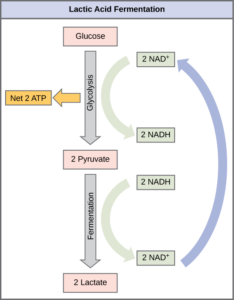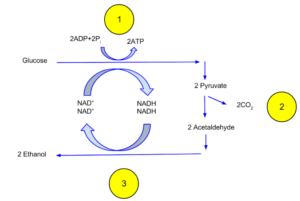Fermentation is a kind of respiration process through which microorganisms generate energy in anaerobic environment, that is in absence of Oxygen. Here we try to find out the answer of is fermentation anaerobic respiration?
Is fermentation anaerobic respiration or not is a very tricky question. Fermentation mostly occurs in anaerobic environment. In that situation after breaking glucose and generating energy the electron transport Chain uses other organic substances (instead of Oxygen molecule) as the last electron acceptor. At the end of the reaction less amount of ATP is produced with some organic substances like (lactic acid, Ethanol, methanol, organic gasses, etc). So we can say that fermentation is an anaerobic respiration process.
Through fermentation occurs in absence of Oxygen or in anaerobic condition but according to some theories typical anaerobic respiration process and fermentation process consist several differences between them. So the anaerobic respiration process and fermentation process are not synonyms at all.
Why is fermentation anaerobic respiration?
Fermentation is a metabolic process that occurs in both intracellular and extracellular environments. It is a kind of anaerobic respiration process.
Fermentation mostly occurs in absence of Oxygen molecule that is why it is an anaerobic respiration. It uses organic substances instead of oxygen as the last electron acceptor molecule and generates less amount of energy (generally 2ATP Per glucose molecule).
Is fermentation always anaerobic?
Though fermentation mainly occurs in anaerobic conditions, typical anaerobic respiration and fermentation processes are not synonyms.
Fermentation process is always anaerobic, which means it occurs in absence of Oxygen or when less oxygen is present in the environment. It uses pyruvate, acetaldehyde, etc as the last electron acceptor. But it is quite different from the typical anaerobic respiration process. It is a modified form of anaerobic respiration process.
Fermentation vs Anaerobic respiration
Though the fermentation and typical anaerobic respiration process both possess several similarities, also have some differences between them. Here we compare both of the processes regarding every possible aspect between them.
| Characteristics | Farmentation | Anaerobic respiration |
| Definition | Fermentation is a metabolic process which produces energy in microorganisms when less amount of oxygen is present in enviornment. | Anaerobic respiration is a respiration process which generates energy in lower class organisms when Oxygen is absent completely. |
| Place of occurrence | It can be an intracellular or extracellular process. That means fermentation can occur inside the organism’s body or can also occur in an external environment artificially. | It is a natural respiration process that only occurs in an intracellular environment. |
| Found in | It is mostly found in eukaryotic microorganisms, such as fungi species (yeast, moods), and also in bacterial cells. It is also found in mammalian muscle cells when cells lack sufficient oxygen supply. | It is mostly found in obligate anaerobic microorganisms such as bacterias, prokaryotes, etc. |
| Molecules used as electron acceptor | In the fermentation process different organic substances like pyruvate, acetaldehyde, etc are used as the last electron acceptor molecule. | In anaerobic respiration process different inorganic substances such as nitrate (NO−3), fumarate(C4H2O2−4), sulfate (SO2−4), or elemental sulfur (S) are used as last electron acceptor molecule. |
| Electrochemical gradient establish | In the fermentation process electrochemical gradient is not established instead of its surface level phosphorylation. | In anaerobic respiration process an electrochemical gradient is established. |
| Importance | Apart from energy generation, it is very important industrially. In food production different fermentation process is used widely. | For obligate anaerobic organisms it is the only way to generate energy. Apart from that it is also important in the biogeochemical cycling process. |
| Product produced | In the fermentation process after glycolysis different organic by-products like ethanol, methanol, lactic acid, etc are produced. | In anaerobic respiration process lactic acid, alcohol, etc are produced. |
| Respiration type | It is a modified form of respiration process evolved from anaerobic respiration process. | It is a primitive type of respiration process when Oxygen absent in the environment, micro organisms use this mode of respiration to generate energy. |
| Examples | Lactic acid fermentation, ethanol Fermentation, etc. | Methanogenesis |

Vs

Farmentation vs Anaerobic respiration from Wikimedia commons
Does anaerobic respiration produce carbon dioxide?
In anaerobic respiration process after Glycolysis, when pyruvate breaks and energy produced different organic and inorganic by-products are genareated.
After completing anaerobic respiration process orgnaic substances, energy and carbon dioxide is produced as by-products in some cases. That means carbon dioxide may or may not be produced in anaerobic respiration. It varies according to the mode.
As an example , in the lactic acid production process carbon dioxide is not produced as a by-product of that reaction. Only lactic acid and 2 molecules of ATP are generated.
C6H12O6 → C3H6O3 + energy (2ATP)

Lactic acid production process from Wikimedia Commons
In the Methanogenesis process carbon dioxide is produced at the end of that reaction as a by-product, with methanol and energy.
C6H12O6 → CH3OH + CO2 + energy
What does anaerobic respiration produce?
Anaerobic respiration produces energy or ATP molecules, organic or inorganic substances as a by-product of the reaction. The energy produced is less than the aerobic respiration process, generally 2 ATP molecules are produced.
In the lactic acid production process lactic acid and energy is produced.
In the alcohol fermentation process Ethanol, carbon dioxide and energy are produced after the reaction.
What does anaerobic respiration produce in plants?
Plants also undergo anaerobic respiration, in the absence of Oxygen molecules.
As same as animal cells plant cells undergo anaerobic respiration process and first complete the Glycolysis process. In the glycolysis process Glucose brakes and 2 molecules of Pyruvate are produced. After this step pyruvate breaks again and produces energy, alcohol and carbon dioxide as by-products of reaction.
What does yeast produce during anaerobic respiration?
Yeast or other fungi species such as molds undergo fermentation to produce energy.
In yeast ethyl alcohol or ethanol fermentation process is found exclusively. At first it completed the Glycolysis process. In the glycolysis process Glucose brakes and 2 molecules of Pyruvate are produced. After this step pyruvate breaks again and produces energy, ethanol and carbon dioxide as by-products of reaction.

Ethanol Farmentation process from Wikimedia Commons
As a whole we can say the fermentation process is one of the most important metabolic processes to produce energy. We try to find out if fermentation is anaerobic respiration or not. We also know about the ecological and industrial importance of this process. Hope this article is fermentation anaerobic respiration Will be helpful to you.
To know more read on Do Humans Have Animal Cells: Interesting FACTS
Also Read:
- Start codon example
- Polymerase chain reaction
- Do mitochondria have ribosomes
- Are proteins molecules
- Chromosome functions in animal cell
- Gravitropism plant example
- Ornamental plant example
- Simple fruit example
- Monounsaturated fat vs polyunsaturated fat
- Non capsulated bacteria

Hello, I am Piyali Das, pursuing my Post Graduation in Zoology from Calcutta University. I am very passionate on Academic Article writing. My aim is to explain complex things in simple way through my writings for the readers.